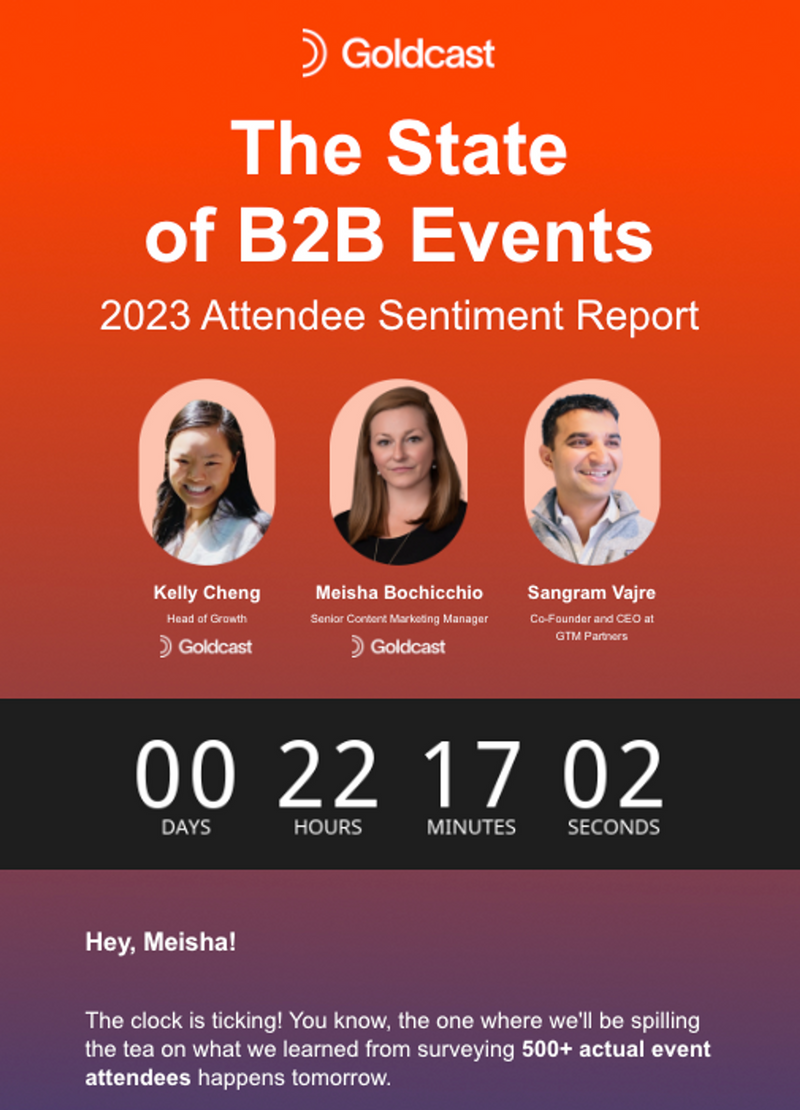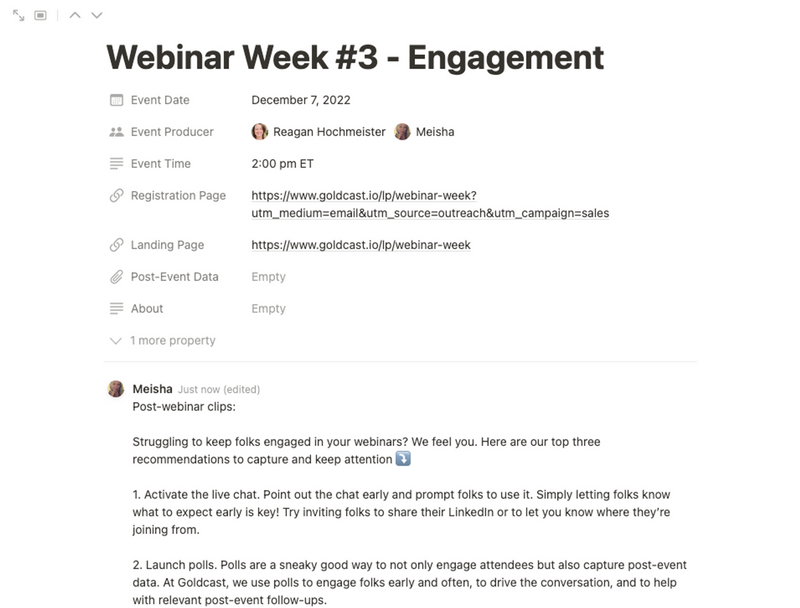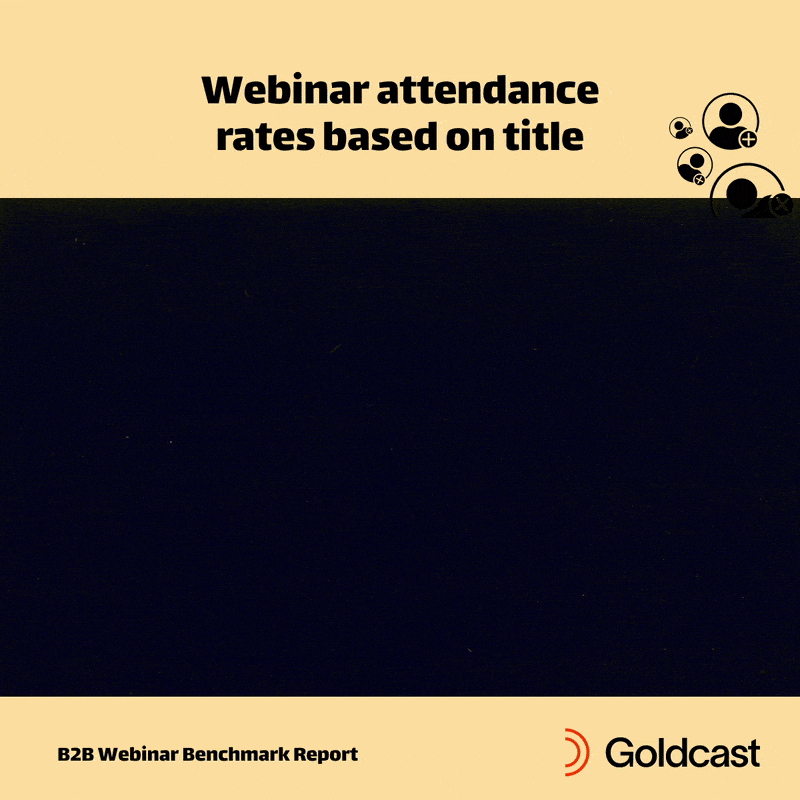How To Increase Webinar Registrations: Creative + Effective Promotion Ideas For Your Webinars
Maximize Your Marketing ROI
Join 10,000 other marketers already getting the best tips on running engaging events that boost pipeline and create raving fans.
Buckle your virtual seatbelts and settle into your favorite chair—2023 is going to bring more webinars than any year before.
In fact, according to our B2B Webinar Benchmark Report, the average company currently hosts 13 webinars per year—in addition to other digital events!
While the explosive growth in the digital events space is exciting, it can also lead to confusion around how to get eyes on your events. How can you stand out from competitors? What are the best ways to raise awareness of your event and promote it to the right people?
You’ve got questions, we’ve got answers. Keep reading for a full breakdown of our most creative and effective webinar promo tactics!
B2B webinar benchmarks
At Goldcast, we've hosted over 100 digital events over the past two years, so we know a thing or two about driving event registrations.
We also took a look at all webinars hosted on our platform to establish some benchmarks. We found that the average registration count across all Goldcast webinars was 257 for each event. Not too shabby, right?
While the registration totals vary greatly depending on the type of webinar and topic, this number serves as a good starting point for benchmarking your own success.
It shouldn’t be surprising that we didn’t start out attracting tons of folks to our own events. We’re a relatively small startup, so we’ve had to get pretty creative to build our audience. But our experimentation paid off, and we now consistently drive hundreds of registrations for our webinars.
We've learned that in order to drive registration and boost attendance, you must be strategic with your promo efforts. Today, we'll tell you everything we know about how to do that!
👋🏽 Psst: Have you downloaded the full B2B Webinar Benchmark Report yet? Grab your copy to learn all the dos and don'ts for webinars!
Before we get into the good stuff, if you're a visual or audio learner, we went live to talk about this topic on Day 2 of Webinar Week. If you'd like to listen in on the full talk by Belinda Joseph, Goldcast's Head of Events, check it out below! ⤵
✨ Psst:You can unlock all of our Webinar Week content on-demand here
What's a "good" number of webinar registrants and attendees?
We just discussed Goldcast's average registration rate: 257 (and growing!).
However, not everyone who registers shows up for an event. Around half of the total registrants tended to actually show up for online events—putting attendance rates at around 129 per webinar.
That means our attendance rate (or conversion rate) was a little over half, at 51%—which is high for industry standards but also cuts our registration number almost in half.
With that in mind, we recommend focusing your webinar marketing efforts on making sure your ideal audience knows about your event. It's not so much about getting people's names on the list as getting the right names.
Your ideal registrant has a higher chance of attending and, ultimately, converting or telling others about your company and content.
Again, we suggest thinking more about how to promote to the right people than honing in on a target number. But if you want to set a benchmark for how many people you'd like to sign up, be sure to take into account factors like:
- What industry you're in and if you serve a smaller niche than others: The smaller the audience, the smaller the pool of potential attendees
- The specific event and its purpose: For example, a webinar on expert tips for current users of your company's product will probably attract fewer people than a general one on product features
- Your level of brand awareness and recognition: If you're a well-known, established brand, you may be able to attract more registrants than a relatively new company
All of these things will influence how many people you're able to reach and motivate to sign up. As you put on more events, you'll start to understand what realistic goals for registration and attendance are and what a successful webinar looks like for you, and you can stretch from there.
Driving webinar registrations is a very real challenge for many marketers
Let's be real: It's one thing to read stats and suggestions on paper, but actually executing on them is a whole different animal.
This stuff is hard!
We recently hosted a few VIP dinners, and we asked people what content marketing and digital event challenges were looming over them going into 2023.
Guess what? A very common response was that event registration and attendance rates are a thorn in people's sides.
People told us that Zoom fatigue prevents potential registrants from even signing up. They talked about the volume of competition out there in the digital events space. They worried about people's attention spans and how to keep them engaged.
If you feel less-than-stellar about bolstering your event attendance rates, you are so not alone. This is something we all struggle with. The best thing to do is to acknowledge our work as marketers is sometimes nebulous and keep moving forward with thoughtful strategies.
Webinar promotion for maximum reach: Our Goldcast marketing strategy
Alright! Now, let's talk about promotion. Knowing what we do, how can we get our event in front of the right folks and encourage them to sign up?
Here's exactly how we promote our own webinars at Goldcast. Read through the prongs of our strategy and see which ones might work for you.
Email marketing via a curated list
First, you want to be sure you're emailing the relevant audience—and only the relevant audience.
To do this, we segment our email list based on the webinar topic. We use filters for things like job titles to align our sends with the people who will be most interested in the subject matter.
Never—we repeat, never—send an email to your entire list! This can come across spammy and cause people to unsubscribe altogether.
We use HubSpot for our promotional sends and push between two to four emails before a webinar, depending on the scale of the event. Big events warrant more emails, and vice versa. We also make sure to suppress people from receiving follow-up emails once they register, so we aren't bothering anyone who's already planning to attend.

For best results, make sure you're clear with your value prop in your email content. Are there incentives for people to attend? Advertise those! What will people walk away knowing that they didn't know before? Outline it boldly!
Everything in marketing is somewhat of an experiment, and email campaigns are no different. You can try A/B testing to see what subject lines get the highest open rates or which call to action (CTA) is more effective, and then use that information for future campaigns.
Social media posts that make sense for our audience (hello, LinkedIn!)
There are lots of social media channels out there. Choose the one(s) where your audience actually hangs out.
For us here at Goldcast, that means LinkedIn, as that's the leading channel for B2B event marketing. We've done the research, and this is where our people are. It wouldn't make much sense for us to spend the time to market ourselves on TikTok when LinkedIn was built exactly for what we are trying to do.
You can check out this post to learn more, but there are so many ways to promote your events on LinkedIn, from Sponsored Content ads, to native ads, to thoughtful hashtags that people can rally around. Enabling your employees to spread the word organically can also be highly effective (we’ll share more on that below).
Zapier automation for the registration flow, which means the registrant details from LinkedIn are automatically brought over to the Goldcast platform. No manual transfer required!
Partners and influencers
This one's all about working smarter, not harder!
Whenever possible, try to leverage the networks of any partners, influencers, and event speakers to get the word out about your live webinar. This will help you reach a much larger audience than you could on your own and get more webinar sign-ups.
We provide our speakers and partners with ready-to-post promo kits, complete with images, copy, and links—all they have to do is post and spread the word.
Communities and newsletters
Wherever you've taken the time to build up virtual or IRL communities who might want to know about your event—whether that's at meetings, through newsletters, or otherwise—share the deets!
You can do this in a number of ways. You could organically post within the communities or include event info in your newsletters. Or you might experiment with paid sends—where you sponsor a community channel or email newsletter—and partnerships for larger campaigns.
For us, our communities include Field & Event Marketing FTW, Event Profs Unite, and our very own Event Marketers Club. What these groups have in common is that their demographics match our target audience—which makes them incredibly valuable to us!
Friendly reminder: Be sure to only promote your event in appropriate channels. Don't spam groups that you don't have a connection to just to get the word out about your event. Your efforts may actually backfire and cause people to have a bad impression of your brand.
Sales enablement and team promotions
Internally, we galvanize our team and empower our sales department to reach out to people they think might be interested.
To start, we get our sales reps on board. We've done a lot of work to understand how to best communicate between teams, and Notion works for us. We set up an event calendar that shows everything that's coming up over the next month; each event card has all relevant info, as well as additional links and documents that sales folks can use. We also include snippets in Outreach, so reps can grab it straight from there and send it out to prospects.

Another thing we've done that works well is to pick a "Social Posting Day" where everyone posts about the event on LinkedIn on the same day. This creates a "surround sound" effect where lots of people find out about the event around the same time—or see the same information multiple times—which helps drive awareness.
Branded registration landing pages
Finally, we take advantage of our own easy-to-customize webinar landing pages.
Depending on the event size and type, we may use a simple webinar registration page built from a template or, for a larger event, build out a bespoke, customized webinar registration form on a page displaying more information.
⚡️ Hot tip: Enable the Slack + Salesforce integration to see webinar registrations in real time!
Make it easy for people to attend your webinar!
So you've done lots of promo and got people signed up. What's next?
Remember that 51% webinar attendance benchmark we talked about earlier? You've got to put in some work to get your rate that high—here's how we make it simple for people to remember and attend our event!
We take the burden off attendees with the following marketing tools:
- Automatic calendar holds: As soon as someone signs up for an event, they get a calendar invite so the event goes straight on their calendar. This enables automatic notifications and gives webinar attendees a place they can easily access the event on the day of.
- Single-click Magic Links: Registrants get a unique URL that they can click to access your event. No one has to remember anything on their own, which can make a huge difference on event day!
- Reminder emails: We typically send three reminders, scheduling emails to go out in the week, days, and hours before an event to keep it top of mind for people. You can even try sending an email out after the event starts to encourage people to join.
Remember that getting people there is only part of the battle. Once they arrive, you'll want to keep them super engaged—here are some tips to try!
One last thing about webinar titles: What's in a name?
Before we close out today, we've got one parting hot tip: Believe it or not, using the word "webinar" in your title can actually impact your attendance rates—and not in the way you might think!
Using "webinar" in your event title appears to lower registration and attendance rates.

We go more in-depth on this in our Benchmark Report, but the short of it is: You need to be creative when it comes to naming your event. Sticking to just the basics (for example, "Marketing Webinar") will probably result in a low registration and attendance rate.
Some alternative ideas: Is your event a 1:1 talk with an industry leader? Call it a "fireside chat." Is it a panel discussion between executives or other professionals? What about "roundtable" instead of "webinar"? Or, if it's a recurring series, brand it like we do with our Event Marketers Live! Experiment with different formats and naming conventions—you might be surprised at what resonates!
Ready for more info on all things webinar?
We've covered a lot of ground today! You now know you should be focusing on promoting your event to the right audiences, as well as some ways we do that at Goldcast through email marketing, LinkedIn campaigns, and more.
We also discussed using automation and email sequences to make it easy for people to remember your event. And, we revealed the one word that you probably don't want to include in your webinar title name.

Transform Your Video Marketing with AI
Stay In Touch
Platform
Resources
© 2025 Copyright Goldcast, Inc. All rights reserved.





 Upcoming Events
Upcoming Events Event Series
Event Series On-Demand Events
On-Demand Events

